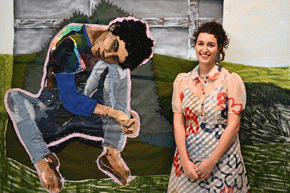Two mighty trees and a sapling: a music review by Fraser Beath McEwing
Two mighty trees and a sapling: that summarised the SSO’s program last night in the Sydney Town Hall.

Miguel Harth-Bedoya
In the mighty department were Tchaikovsky’s fourth symphony and Brahms’ fist piano concerto, supported by a sapling Uplift, a new Australian work in the Fifty Fanfares Commission.
Uplift was the work of Jessica Wells who has made her name in film music, as well as an acclaimed arranger and composer across many musical genres. Uplift depicts the experience of a pilot waiting for clearance on the runway, then taking off and feeling the exhilaration of flying. This was achieved with some clever orchestration and a wonderful climatic finish that used the entire, well-stocked SSO. Although Jessica Wells probably spends most of her composing time on film scores and short pieces, I’d like to hear how she’d craft a work of around 45 minutes.
Brahms’s two piano concertos are giants of the genre. The Piano Concerto No. 1 in D minor, Op. 15, was completed in1858. Brahms, a highly regarded concert pianist, gave the work’s public debut in Hanover the following year. It was his first orchestral work to win audience approval on its first outing.
The SSO invited Macedonian pianist Simon Trpčeski to be the soloist. I well remember his Sydney recital in July 2018 as a highlight of the piano series, and I looked forward to hearing what his explosive/romantic delivery would bring to the Brahms concerto.

Simon Trpceski
The concerto has a strange opening. Any piece that begins with incessant thunder from the tympani is signalling drama to come. And come it does, sounding like a symphony and seeming to have forgotten the pianist who sits patiently waiting to lay into the rapid thirds and demanding double trills that open his account.
In a word, this was superb playing – orchestra as well as soloist. Even though much of the concerto was taken at a dangerous speed, Trpčeski devoured it, and when it came to pianissimo passages, he was able to project them to the back of the Town Hall while still being faithful to the marks.
Trpčeski also had an endearing stage presence. At times he played the role of second conductor as he became immersed in the music, moving in sympathy with hand and body.
By its position as the post-intermission work, Tchaikovsky’s fourth symphony was intended to be the major work of the concert. I think it was outshone by the Brahms, but it followed SSO practice of playing a concerto prior to intermission. That is not to say that Pyotr Ilyich was left in the shade. His fourth symphony shakes the listener’s bones.
To give some background to Tchaikovsky’s Symphony No. 4 in F minor, Op. 36: it was written between 1877 and 1878 and dedicated to his friend and patron, Nadezhda von Meck. This was a time that saw the tragic turmoil of his marriage unfold. That may have influenced the symphony, the first movement in particular, evoking the majesty and cruelty of fate. The fanfare opening has much in common with the opening of Beethoven’s fifth symphony which also explores fate. And let’s not forget the pizzicato third movement that is very unkind to the skin on the tips of the string players’ fingers. I wouldn’t be surprised if there was a box of Band-Aids in the green room.
The SSO was in fine form and got right to the heart of the symphony. The fourth movement said it all. It blasted forth at breakneck speed that showed off the technique of the players, especially brass and percussion. And it certainly stirred the audience – although a few stick-in-the-muds like me found it a trifle too fast.
Peruvian conductor, Miguel Alberto Harth-Bedoya, was the first overseas guest conductor for the SSO in two covid stressed years. And he was a good choice because he brought excitement to the music. He conducted the Tchaikovsky without a score and he also used a podium without a railing. If he’d lost his footing, he would have landed in the front row on somebody’s lap. He is currently director of orchestral studies at the Baylor University in Waco, Texas. His own early studies were at the Curtis Institute in Philadelphia and the famed Julliard School in New York.
SSO Sydney Town Hall concert 4 May 2022







